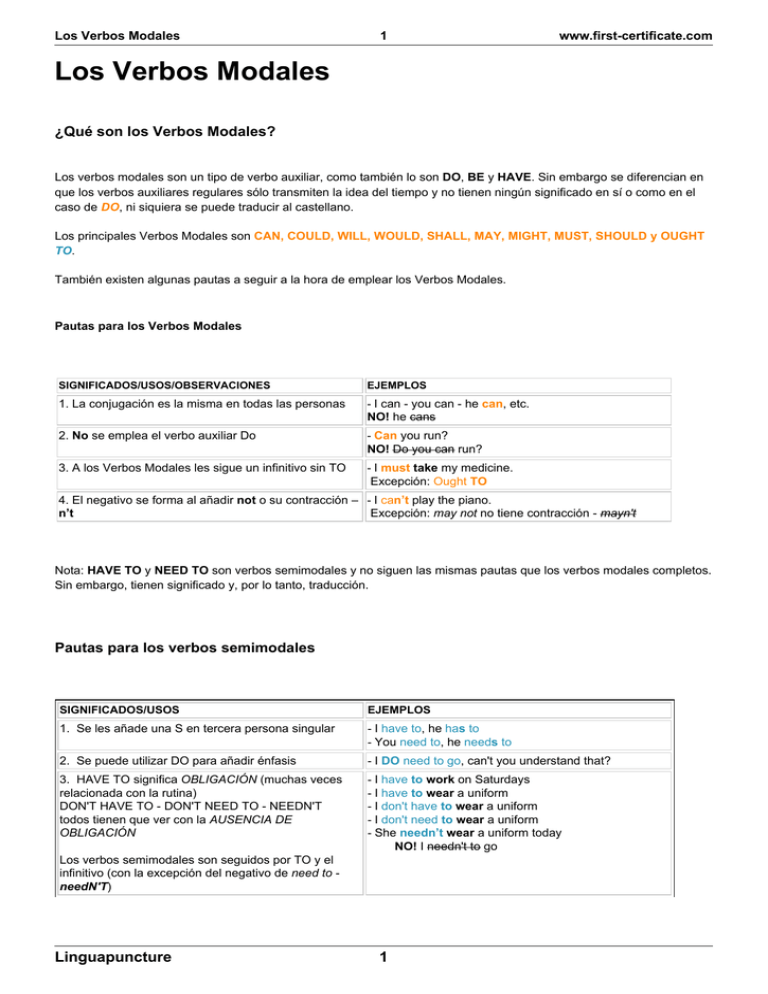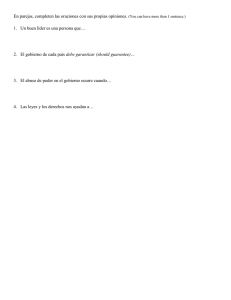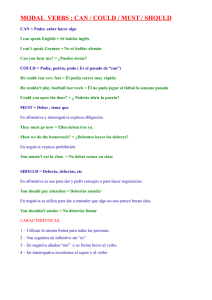Los Verbos Modales - First Certificate
Anuncio

Los Verbos Modales 1 www.first-certificate.com Los Verbos Modales ¿Qué son los Verbos Modales? Los verbos modales son un tipo de verbo auxiliar, como también lo son DO, BE y HAVE. Sin embargo se diferencian en que los verbos auxiliares regulares sólo transmiten la idea del tiempo y no tienen ningún significado en sí o como en el caso de DO, ni siquiera se puede traducir al castellano. Los principales Verbos Modales son CAN, COULD, WILL, WOULD, SHALL, MAY, MIGHT, MUST, SHOULD y OUGHT TO. También existen algunas pautas a seguir a la hora de emplear los Verbos Modales. Pautas para los Verbos Modales SIGNIFICADOS/USOS/OBSERVACIONES EJEMPLOS 1. La conjugación es la misma en todas las personas - I can - you can - he can, etc. NO! he cans 2. No se emplea el verbo auxiliar Do - Can you run? NO! Do you can run? 3. A los Verbos Modales les sigue un infinitivo sin TO - I must take my medicine. Excepción: Ought TO 4. El negativo se forma al añadir not o su contracción – - I can’t play the piano. n’t Excepción: may not no tiene contracción - mayn't Nota: HAVE TO y NEED TO son verbos semimodales y no siguen las mismas pautas que los verbos modales completos. Sin embargo, tienen significado y, por lo tanto, traducción. Pautas para los verbos semimodales SIGNIFICADOS/USOS EJEMPLOS 1. Se les añade una S en tercera persona singular - I have to, he has to - You need to, he needs to 2. Se puede utilizar DO para añadir énfasis - I DO need to go, can't you understand that? 3. HAVE TO significa OBLIGACIÓN (muchas veces relacionada con la rutina) DON'T HAVE TO - DON'T NEED TO - NEEDN'T todos tienen que ver con la AUSENCIA DE OBLIGACIÓN - I have to work on Saturdays - I have to wear a uniform - I don't have to wear a uniform - I don't need to wear a uniform - She needn’t wear a uniform today NO! I needn't to go Los verbos semimodales son seguidos por TO y el infinitivo (con la excepción del negativo de need to needN'T) Linguapuncture 1 Los Verbos Modales 4. El negativo NEED NOT + INF sin to puede contraerse El negativo HAVE TO no puede ser contraído 2 www.first-certificate.com - They needn’t go. NO! They haven’t to go. Una lista con los significados y usos de los Verbos Modales Tal como ya se ha descrito anteriormente, los Verbos Modales y verbos semimodales tienen un significado. He aquí una lista de los Verbos Modales y los verbos semimodales con sus significados y usos. SIGNIFICADOS/USOS EJEMPLOS CAN 1. Para expresar capacidad 2. Para pedir permiso 3. Para hacer una petición 4. Para expresar posibilidad 1. I can speak English. 2. Can I borrow your pen. 3. Can you open the window? 4. I can come next Monday. COULD 1. Para expresar capacidad en el pasado 2. Para hacer una petición cortés 3. Para expresar permiso dentro del estilo de Voz Indirecta 4. Para expresar posibilidad 5. Para el Segundo Condicional 1. I could run fast when I was a child. 2. Could you open the window, please? 3. Mary said she could go out tonight. 4. Where’s Mary? I don’t know, she could be in her office. 5. If it didn’t rain, we could go to the park. WILL 1. Para expresar certeza 2. Para el futuro: - con las decisiones espontáneas - con las predicciones 3. Para expresar una promesa 4. Para dar órdenes 5. Para el Primer Condicional 1. He will definitely come to the party 2a. I will call Mary before she leaves. 2b. I think the economy will get better soon. 3. I will return your money tomorrow. 4. You will do as I tell you. 5. If it stops raining we will play football. WOULD 1. Para hacer una oferta cortés 2. Para los Condicionales 3. Para expresar las costumbres en el pasado 1. Would you like some cheese? 2. If I had a car I would change my job. 3. On Sundays we would go to the park to play football. SHALL 1. Para el futuro 2. Para expresar una promesa 3. Para pedir consejo 4. Para hacer una oferta cortés 5. Para preguntar instrucciones 6. Para dar órdenes 1. I shall visit Mary next week. 2. I shall help you with your homework. 3. Shall I invite Jim to the party? 4. Shall I open the window for you? 5. Where shall I put this box? 6. You shall go there immediately. MAY 1. Para expresar posibilidad 2. Para dar permiso 3. Para hacer una petición cortés 4. Para hacer una oferta cortés 1. I may be able to take a day off. 2. May I use your phone? 3. May I have some more cake, please? 4. May I help you? MIGHT 1. Para expresar posibilidad 1. We might be able to join you in London next week. SHOULD 1. Para hacer una recomendación 2. Para hacer una sugerencia 3. Para expresar Probabilidad/Suposición 4. Para dar un consejo 1. You should read this book, it’s great. 2. Perhaps we should consider a different option. 3. They should be at home by now. 4. You should see a doctor at once. Linguapuncture 2 Los Verbos Modales 3 www.first-certificate.com OUGHT TO 1. Para expresar obligación moral 2. Para hacer una recomendación 3. Para expresar probabilidad 1. You ought to do as you are told. 2. You ought to see the Picasso museum. 3. They ought to be be home by now. MUST 1. Para expresar obligación 2. Para expresar necesidad 3. Para hacer una deducción/suposición 4. Para hacer una invitación 1. You must wear protective glasses in the lab. 2. I must take my medicine. 3. They left at 8 o’clock, so they must be at home by now. 4. You must stay at my house when you come to the city. HAVE TO 1. Para expresar Obligación 1. I have to wear safety goggles in the lab. NEED TO 1. Para expresar Necesidad 1. I need to take my medicine with my breakfast. Los verbos modales en negativo SIGNIFICADOS/USOS EJEMPLOS CAN’T Para expresar certeza · Mr. Simpson can’t be dead, I saw him only 5 minutes ago. MUSTN’T Para expresar prohibición · DON’T HAVE TO No es necesario · You don’t have to go to the party if you don’t want to. OUGHT NOT (TO) Para dar un consejo directo o OUGHTN'T (TO) Para dar un consejo indirecto · · You mustn‘t smoke in a hospital. You ought not (to) walk, your leg's bad, John ought not (to) walk, his leg’s bad Nota: La forma negativa de OUGHT TO no se considera correcta con el TO, pero es comúnmente utilizada. Linguapuncture 3

![2. decir – to say, tell [yo digo] 6. repetir – to repeat 7. reír – to laugh](http://s2.studylib.es/store/data/004577496_1-921269dc49beb854639c32fc2fea858d-300x300.png)


